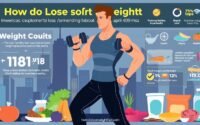Fast Fat Loss in Australia: The Ultimate Guide
Did you know that over 67% of Australian adults are classified as overweight or obese? This statistic highlights the growing need for effective strategies to achieve a healthy weight and improve overall health. With so many options available, finding the right approach can feel overwhelming. But don’t worry—this guide is here to help.
From tailored diet plans to proven exercise routines, there are numerous ways to reach your goals. Programs like the CSIRO Total Wellbeing Diet focus on sustainable methods, while telehealth services like Mosh connect you with AHPRA-registered doctors for personalized advice. Additionally, initiatives like LiveLighter encourage active lifestyles to support your journey.
Understanding the risks of visceral fat and setting SMART goals can make a significant difference. Combining a caloric deficit with regular physical activity, such as 30-minute daily workouts, can help you see results. For more tips, check out these 3 weird hacks to burn fat.
Key Takeaways
- Over 67% of Australian adults are overweight or obese.
- Programs like CSIRO Total Wellbeing Diet offer sustainable solutions.
- Telehealth services provide personalized medical weight loss plans.
- Regular exercise and a caloric deficit are key to success.
- SMART goals help maintain focus and track progress.
Understanding Fat: What You Need to Know
Not all fat is created equal—some types pose serious health risks. While subcutaneous fat lies just under your skin, visceral fat is stored deep within your abdomen, surrounding vital organs. This hidden fat is far more dangerous than it appears.
What is Visceral Fat and Why is it Dangerous?
Visceral fat isn’t just a storage site; it’s an active organ that releases harmful chemicals. These substances are linked to over 13 health conditions, including high blood pressure, heart disease, and type 2 diabetes. It also plays a role in metabolic syndrome, a cluster of conditions that increase your risk of chronic diseases.
Here are some specific risks associated with visceral fat:
- Increased likelihood of dementia and cognitive decline.
- Higher risk of osteoarthritis and joint issues.
- Potential fertility problems in both men and women.
“Visceral fat accounts for only 10% of body fat but contributes to 90% of health complications.”
How to Measure Your Visceral Fat Levels
One simple way to assess your visceral fat is by measuring your waist. For women, a waist measurement of 80cm or more indicates dangerous levels. For men, it’s 94cm or more. Here’s how to do it:
- Stand straight and breathe out naturally.
- Wrap a tape measure around your waist, just above your belly button.
- Ensure the tape is snug but not too tight.
Genetics can also play a role in fat storage, so understanding your family history is helpful. Tools like Healthdirect Australia’s free BMI calculator can provide additional insights. Postmenopausal women should be especially cautious, as hormonal changes can increase visceral fat accumulation.
For more information, check out LiveLighter’s educational materials on toxic fat. Understanding your body is the first step toward better health.
Setting Realistic Weight Loss Goals
Achieving your desired results starts with setting clear and realistic objectives. Without a solid plan, it’s easy to feel overwhelmed or lose motivation. That’s why understanding how to set achievable targets is crucial for long-term success.
Why Setting SMART Goals is Crucial
The SMART framework is a proven method for creating effective goals. SMART stands for Specific, Measurable, Achievable, Relevant, and Time-bound. For example, instead of saying, “I want to lose weight,” a SMART goal would be, “I aim to lose 5kg in 12 weeks by following a structured program.”
Here’s how to apply the SMART framework:
- Specific: Define exactly what you want to achieve.
- Measurable: Track your progress with numbers or milestones.
- Achievable: Set goals that are realistic for your lifestyle.
- Relevant: Ensure your goals align with your overall health objectives.
- Time-bound: Set a deadline to stay focused.
How to Break Down Your Weight Loss Journey
Breaking your journey into smaller steps makes it more manageable. Start with an initial target, like losing 5% of your body weight. For someone weighing 100kg, this means aiming for 95kg. Research shows that even this small change can significantly reduce health risks.
Here are some tips to help you stay on track:
- Use tools like MyFitnessPal to track your food intake and progress.
- Take the CSIRO Diet Type quiz to find a plan that suits your needs.
- Focus on non-scale victories, such as improved energy levels or better sleep.
It’s also important to avoid the “all or nothing” mentality. Small, consistent changes are more sustainable than drastic measures. Programs like the Better Health Coaching Service in South Australia can provide additional support and guidance.
Remember, maintaining a healthy lifestyle is about progress, not perfection. Celebrate every step forward, and don’t get discouraged by temporary setbacks.
The Role of Diet in Fast Fat Loss
Your diet plays a pivotal role in shaping your health and achieving your goals. What you eat not only fuels your body but also influences how effectively you can reduce body fat. By focusing on the right food groups and managing your calories, you can create a sustainable plan that works for you.

Best Foods for Reducing Body Fat
Certain foods are particularly effective in helping you achieve your goals. For example, the CSIRO’s 40% protein meal structure is designed to reduce hunger while supporting fat reduction. Low GI foods like basmati rice and whole grains provide sustained energy, keeping you fuller for longer.
Here are some top picks to include in your diet:
- Lean proteins like chicken, fish, and tofu.
- Fiber-rich vegetables such as broccoli and spinach.
- Healthy fats from avocados, nuts, and seeds.
Meal replacement shakes approved by the TGA can also be a convenient option for busy days. For more tips on healthy eating, check out Healthdirect Australia’s guide.
How to Create a Caloric Deficit Without Feeling Hungry
Creating a caloric deficit is essential for fat reduction, but it doesn’t mean you have to feel hungry. Choosing nutrient-dense foods can help you stay satisfied while consuming fewer calories. For instance, a 500-calorie chicken salad will keep you fuller longer than a 500-calorie pizza.
Here’s how to manage your intake effectively:
- Focus on protein-rich meals to take advantage of the thermic effect of digestion.
- Incorporate low-calorie, high-volume foods like leafy greens and cucumbers.
- Practice mindful eating to avoid overeating.
Programs like the CSIRO Total Wellbeing Diet offer structured plans to help you achieve your goals without feeling deprived. Remember, small changes can lead to big results over time.
Exercise: Your Secret Weapon for Fat Loss
Exercise is a powerful tool for transforming your body and improving your health. According to the AIHW, adults should aim for at least 150 minutes of moderate physical activity weekly. This not only helps you burn calories but also boosts your overall well-being.

Whether you prefer cardio, strength training, or a mix of both, there’s a way to make it work for you. The key is consistency and finding activities you enjoy. Let’s explore the best options to help you achieve your goals.
Cardio vs. Strength Training: What Works Best?
Both cardio and strength training offer unique benefits. Cardio, like running or cycling, is great for burning calories during the workout. On the other hand, strength training helps build muscle, which increases your resting metabolic rate.
Here’s a quick comparison:
- Cardio: Burns more calories during the session. A 30-minute treadmill run can burn around 300 calories.
- Strength Training: Preserves lean mass while cutting. Studies show it retains 97% of muscle during weight loss.
For the best results, combine both. This approach maximizes calorie burn and supports long-term health.
High-Intensity Interval Training (HIIT) for Quick Results
HIIT is a time-efficient way to boost your fitness. It involves short bursts of intense exercise followed by brief rest periods. Research shows HIIT burns 25-30% more calories than traditional weight training.
Here’s a simple bodyweight HIIT routine to try:
- 30 seconds of jumping jacks
- 30 seconds of squats
- 30 seconds of push-ups
- 30 seconds of rest
Repeat this circuit 3-4 times for a quick, effective workout. HIIT also triggers the EPOC effect, where your body continues to burn calories even after the session.
Remember, overtraining can lead to injuries. Listen to your body and take rest days when needed. For structured guidance, consider Fitness First class packages or corporate gym membership rebates.
Lifestyle Changes for Sustainable Fat Loss
Your daily habits play a significant role in shaping your health. While diet and exercise are essential, other factors like sleep and activity levels can make a big difference. By focusing on these areas, you can create a balanced approach to maintaining healthy results.
The Importance of Sleep and Stress Management
Sleep is often overlooked, but it’s crucial for your well-being. Studies show that getting less than 7 hours of sleep can increase cravings by 33%. Poor sleep also raises cortisol levels, which is linked to belly fat accumulation.
Managing stress is equally important. High cortisol levels not only affect your weight but also your overall health. Here are some tips to help get started:
- Practice mindfulness with apps like Headspace.
- Follow Sleep Health Foundation guidelines for better rest.
- Incorporate relaxation techniques like deep breathing or yoga.
“Managing stress and prioritizing sleep are foundational steps toward a healthier lifestyle.”
How to Stay Active Throughout the Day
Regular exercise is vital, but staying active outside the gym matters too. Non-exercise activity thermogenesis (NEAT) accounts for 15% of your total daily energy expenditure. Simple changes can add up:
- Set step targets using a Fitbit or Apple Watch.
- Convert to a standing desk to reduce sedentary time.
- Join lunchtime walking meetups for social and physical health benefits.
Here’s a quick office chair stretch routine to keep you moving:
- Stretch your arms overhead for 10 seconds.
- Twist your torso gently to each side.
- Roll your shoulders backward and forward.
Programs like NSW Health’s workplace wellness initiatives can also support your efforts. Remember, small changes lead to big results over time.
| Activity | Health Benefits |
|---|---|
| Walking 10,000 steps | Improves cardiovascular health |
| Using a standing desk | Reduces back pain and boosts energy |
| Mindfulness practices | Lowers stress and improves focus |
Fast Fat Loss in Australia: Tips and Tricks
Finding the right support can make all the difference in your journey. Whether you’re looking for expert advice or community encouragement, there are plenty of resources to help you stay on track. From local programs to online communities, you’ll find the tools you need to succeed.
Local Resources and Programs to Support Your Journey
Australia offers a variety of programs designed to help you achieve your goals. For example, Get Healthy NSW provides free coaching services tailored to your needs. You can also explore the LiveLighter recipe hub, which features over 600 healthy meals to inspire your cooking.
Here are some other options to consider:
- State-based coaching services for personalized support.
- Comparison of popular programs like Jenny Craig and Lite n’ Easy.
- Bulk-billing GP weight clinics for medical guidance.
Seasonal farmers markets are another great way to access fresh, local produce. They’re perfect for adding variety to your meals while supporting local growers.
How to Stay Motivated and Avoid Common Pitfalls
Staying motivated can be challenging, but with the right tips, you can overcome obstacles. One common issue is hitting a plateau, where progress seems to stall. To bust through, try adjusting your routine or seeking advice from a doctor or nutritionist.
Here’s a checklist to help you stay on track:
- Set small, achievable goals to maintain momentum.
- Join support groups like Mosh’s Facebook community with 23k members.
- Celebrate non-scale victories, such as improved energy or better sleep.
“Success is built on consistency, not perfection. Every step forward counts.”
Be cautious of products claiming to be “fat burners.” Many are scams that can harm your health. Instead, focus on sustainable changes and high-quality resources like Chemist Warehouse’s supplement guides.
Remember, your journey is unique. By leveraging local programs and staying motivated, you can achieve lasting results.
Conclusion
Transforming your health is a journey that starts with small, consistent steps. Remember, a waist measurement of 80cm or more for women and 94cm or more for men indicates higher health risks. Focus on a 12-week timeline to see meaningful changes, combining a balanced diet with regular exercise for the best results.
If you ever feel stuck, reach out to resources like Get Healthy NSW or Medicare for support. Avoid quick-fix scams that promise unrealistic results. Instead, trust proven programs like the CSIRO Total Wellbeing Diet, which offers a free trial to help you get started.
Your journey to a healthy lifestyle is unique. Celebrate every milestone, no matter how small. With determination and the right tools, you can achieve lasting benefits for your health and well-being.
FAQ
What is visceral fat and why is it dangerous?
Visceral fat is the fat stored around your internal organs. It’s dangerous because it’s linked to health issues like heart disease, high blood pressure, and type 2 diabetes. Reducing it is key to improving your overall health.
How can I measure my visceral fat levels?
You can measure visceral fat using methods like waist circumference, body scans, or bioelectrical impedance scales. Consulting a doctor for accurate measurements is also a great option.
Why is setting SMART goals crucial for weight loss?
SMART goals (Specific, Measurable, Achievable, Relevant, Time-bound) help you stay focused and track progress. They make your weight loss journey more manageable and keep you motivated.
What are the best foods for reducing body fat?
Foods like lean proteins, whole grains, vegetables, and healthy fats are great for reducing body fat. They keep you full, boost metabolism, and support your weight loss plan.
How can I create a caloric deficit without feeling hungry?
Focus on nutrient-dense, low-calorie foods like fruits, vegetables, and lean proteins. Eating smaller, frequent meals and staying hydrated can also help curb hunger.
What works better for fat loss: cardio or strength training?
Both are effective, but combining them gives the best results. Cardio burns calories quickly, while strength training builds muscle, which helps you burn more calories at rest.
How does HIIT help with quick results?
High-Intensity Interval Training (HIIT) burns a lot of calories in a short time and boosts your metabolism. It’s efficient and effective for those with a busy schedule.
Why are sleep and stress management important for fat loss?
Poor sleep and high stress can disrupt hormones that control hunger and metabolism. Managing these helps you stay on track with your weight loss goals.
What local resources can support my weight loss journey in Australia?
Australia offers programs like the Healthy Weight Guide, gyms, and nutritionists. Local community groups and online forums can also provide support and motivation.
How can I stay motivated and avoid common pitfalls?
Set small, achievable goals, track your progress, and celebrate milestones. Surround yourself with supportive people and remind yourself of the health benefits you’re working toward.


